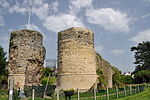Earsham
Civil parishes in NorfolkNorfolk geography stubsVillages in Norfolk

Earsham is a village and civil parish in the English county of Norfolk. Earsham is located 1.7 kilometres (1.1 mi) west of its postal town of Bungay and 21 kilometres (13 mi) south-east of Norwich. The village is located close to the border between Norfolk and Suffolk, and the River Waveney.
Excerpt from the Wikipedia article Earsham (License: CC BY-SA 3.0, Authors, Images).Earsham
Old Railway Road, South Norfolk Earsham
Geographical coordinates (GPS) Address Nearby Places Show on map
Geographical coordinates (GPS)
| Latitude | Longitude |
|---|---|
| N 52.451825 ° | E 1.417236 ° |
Address
Old Railway Road (Waveney Valley Line)
Old Railway Road
NR35 2TD South Norfolk, Earsham
England, United Kingdom
Open on Google Maps










